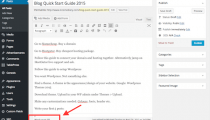
10 SEO Blog Post Publishing Steps that Most Bloggers Forget
I see this time and time again.
People start out blogging; thinking it’s as simple as clicking, “Add New Post,” type a few paragraphs and click “Publish.”
Then they hopelessly wait for views, comments, and tweets.
No one comes. No one comments. No one tweets.
They do this three or four times and eventually write off blogging as, “not it’s all hyped up to be.”
After writing for IncomeDiary for a few months now, I can tell you that there are dozens of small blogging nuances that we work into nearly every post.
Here are 10 of the most popular SEO blog post publishing steps that bloggers tend to forget.
Updated May 2020 to include SEO Essentials today’s blogger should know about.
1. Keyword Research
Before I write a single word, I figure out if it’s something that people are asking about. And if they are, I want to know if the internet is already saturated with that type of content.
To figure this out, I use SEMrush Keyword Magic Tool – I look up the words I believe people would search for to find the post I plan on writing. Using this tool I can see how much traffic a search term gets and what the competition looks like.
I want this post to rank for “SEO blog post publishing steps” (click to see how it’s doing).
For more clarification on this tip, read this comment below.
Related:
Best Keyword Research Tools Reviewed
The Best Tools For Tracking Your Website Performance
2. Fine-Tuning the Headline
Here’s my formula for crafting headlines for list posts:
[#][keyword][ curiosity-capturing phrase]
For title tag SEO, your goal is to place the keyword as near to the front of the headline as possible:
- Top 10 Motivational YouTube Videos for Entrepreneurs
- 20 Great Google Chrome Extensions for Online Entrepreneurs
- 20 Best Designed Pricing Comparison Tables
For that last one, I switched the keyword with the curiosity phrase because “Best Designed” was another phrase that people tack on to the base keyword.
3. Post Slug
The post slug is what shows up after the domain for every post or page.
When you type a headline, WordPress generates the post slug by placing every word in the headline into the slug. This clutters it up with lots of small words.
Instead, change your post slug to your primary keyword.
Default: IncomeDiary.com/10-seo-blog-post-publishing-steps-that-most-bloggers-forget/
Ideal: IncomeDiary.com/seo-blog-post-publishing-steps/
4. Images
We all know that images grab your attention, break up the content, and supplement your ideas. But they also add great SEO benefits, as long as you follow these steps:
- Save your images as [keyword-phrase.png] before you upload them to your site.
- Add alt text as [keyword phrase].
- Add title tag as [keyword phrase].
These rules apply to your featured image and the images within your posts. For the images within the content, however, use other similar and relevant keywords.
5. External Linking – [Plus Build Backlinks]
Most people understand the benefits of building backlinks to your website and how it benefits SEO.
But less frequently mentioned is external links to other websites. Your goal should be to provide the most complete resource for your reader and one way to do that is by providing useful external links that readers can follow up for further information.
Look for opportunities to link to other bloggers.
As Neil Patel says:
Did you know that an external links going out to these high authority sites can boost your SEO? When search engines crawl your site and see a link and follow it to CNN or Huffington Post, they weight it as a positive. The trick is to find organic ways to link to these sites, like I did in this post.
Linking to other sites is also a good way to build relationships with other bloggers.
I’ve received two “thank you” emails from important people because I chose to link to their sites on IncomeDiary posts.
I linked to Pat’s site on 10 Blog Posts that Made an Everlasting Impact on Me
I linked to Giancarlo’s site on 10 Weird Ways Big Companies Make Money Online
Bloggers notice and appreciate backlinks. They are also more likely to share your content on social media.
In regards to improving SEO by building backlinks – check out these posts:
Also, this short 6.18 min video provides some excellent tips for getting backlinks.
How to Get High-Quality Backlinks for FREE
6. Relevant Videos
Google understands that adding a video to a blog post makes it a more complete resource. If they haven’t already boosted blog posts with videos, they will eventually. [See how we added a video above]
If blogging is a big portion of your business, start making videos for your posts, upload them to your channel, and embed them in the actual post.
If you’re still dabbling in blogging, consider embedding other peoples’ videos in your posts – just like we are doing below…
Perfect WordPress SEO Setup (Increase Speed, Traffic + Best Plugins)
7. Subheads
Similar to images, subheadings break up the content and make blog posts easier to read. They also have big-time SEO benefits.
When a search engine robot hits a page, it reads the headline/title tag first. Then it reads the H2, H3, and H4 tags.
When you add subheadings to your content, proper HTML is:
<h2>Subhead Level 1</h2>
<h3>Subhead Level 2</h3>
<h4>Subhead Level 3</h3>
Note: The headline/title tag should be automatically wrapped in <h1></h1>.
So… Stop simply bolding and italicizing your subheads.
8. Interlinking
Another important step that most people forget is interlinking between your blog posts.
Before you publish a new post, read through it and try to find two-three related articles with your blog that you can link to.
This keeps both readers and search spiders on your site longer. (and lowers your bounce rate)
9. Meta Data
Whether or not Google still looks at meta keywords is up for debate, but the meta description is definitely still used.
In a search result, your meta description often shows up as the little blurb beneath the blue link. In writing your meta description, you need to keep three things in mind:
- It needs to be fewer than 155 characters so Google will display the whole description.
- It needs to include your keywords because Google bolds them in search results.
- It should be an actual sentence from the post because people look for that sentence once they arrive.
I always summarize the post with the keywords in the last sentence of the introduction and use that as the meta description.
10. A Call to Action
The final step is the call-to-action. As with any piece of marketing material, a blog post should be designed to get someone to do something.
Here are a few popular calls to action:
- Comment – You can encourage people to comment by ending the post with a thought-provoking question or simply asking them to let you know what they think.
- Share – “If you liked this post, tweet it out.”
- Implement – I believe the best result of any blog post is for a reader to take your advice and implement it.
The main reason I’ve been following IncomeDiary for so long is that I constantly find myself implementing the advice I read here.
When I see the benefits of following this advice, it makes me want to come back for more.
SEO Essentials Every Blogger Should Know About
[Updated May 16th, 2020]
Rather than looking for short-cuts to SEO success.
More bloggers should read Google’s Webmaster Guidelines.
Getting a website to rank consistently requires effort and commitment.
Google’s guidelines are a good place to start.
The SEO Essentials
Keyword Research and On-page optimization.
On-page optimizing is the work you do to rank a page higher in the search engines. It includes both the content and HTML source code (meta tags).
Link building. (off-page SEO)
Off-page SEO refers to links and external signals (such as Social Signals – number of shares in social media)
Quality content is content that helps people. It answers questions; it entertains people; it tells people how to do something. It is content that Google considers useful.
Use Meta Tags.
Meta tags (metadata) provide information about your webpage within the HTML. While they do not display it on the page, the search engines can read them. Examples of meta tags include the <title> and <description>.
You should treat the meta description as an advert for your webpage. Make it something people will want to click on while including your main keyword/s.
There is some argument if meta descriptions are still a ranking factor in Google, but that is not why I use a meta description. I use the meta description to attract clicks and visitors to my website.
One thing most people no longer bother with is meta keyword tags. In the past, it was frequently used to spam search engines and I understand Google ignores it.
A lot of first-time bloggers find technical SEO confusing.
In short, technical SEO includes: making a website fast, secure, (HTTPS) easy to crawl, and understandable to search engines.
It also includes regular removal of dead links, (use a Plugin for that) creating an XML sitemap, and if you are an international business using Hreflang tags.
Hreflang tags solve duplicate content problems. For example, if you have a US and UK site showing the same content, Google will know the content is written for a different region. This is not something that most bloggers need to worry about, but it is something you should be aware of if you are using a country-specific domain extension.
Read more: ‘9 Reasons Why You’re Not Getting Search Engine Traffic’
Modern SEO Essentials
Like we said, the basics don’t change.
But, how you implement the basics has changed.
The above processes have become more complex and tricky to implement.
Modern Link-building Techniques
When I started out webmasters exchanged links, and that seemed to work.
Not any more.
Hang around with SEO people long enough and you will hear them discuss various link-building strategies – often in hushed tones!
You will hear about “Shotgun Skyscraper outreach” and “Broken link building” and “Content repurposing/syndication”
If you are serious about SEO, you will need to understand these terms.
I recommend this paid training.
Keyword Research Today
You need to understand and master all of these:
- Niche keywords
- Short Tail keywords
- Long-Tail Keywords
- Keyword synonyms
- Phrase Match Keywords
- Broad Match Keywords
- Branded Keywords
- Negative Keywords
- Exact Match Keywords
Plus, my favorite type of keyword:
Money Keywords
With bloggers, “Money keywords” are keywords that match the offer you are promoting.
As an example, let’s say you rank for “white goods product + model number” the chances are high anyone landing on your page is looking to purchase that product.
It is one thing to be good at SEO and content creation, but another to rank for money keywords.
Quality Content Creation Today
When writing use the E-A-T formula.
Expertise, authority, and trust. [EAT]
All your content should build on your expertise, authority, and trustworthiness.
That is how you get your website to stand out from the crowd.
Learn more about E-A-T in this Medium post.
As mentioned earlier…
Quality content is content that helps people. It answers questions; it entertains people; it tells people how to do something. It is content that Google considers useful.
A long-term SEO strategy is vital. That starts with quality content.
Whatever you do, don’t indulge in black-hat SEO or even grey-hat SEO. Neither of these approaches is sustainable long term. Sure you may get some short-term rankings, but it is not a question of “if” you will get penalized but “when” you get penalized.
If you plan to build a long term business asset that you can sell one day, you will only want to use white-hat SEO strategies.
Beware Thin Content
Thin content pages are pages with low word counts.
Often they will be of little value to visitors and have a high bounce rate.
Thin content pages include: pages with duplicate content, automatically generated content, copy and pasted affiliate content, and scraped content.
If you have a webpage with hundreds rather than thousands of words it is likely your content will be classed as “thin content”.
Can you elaborate or improve on these pages?
Sometimes the blogger had a good idea but failed to implement it well.
If you are not ranking, look at your content and the word count and ask yourself, “what can I do to improve this blog post?” Actually, do that with every post, even the ones that rank fine.
You don’t write a blog post and forget. You write a blog post and improve!
Don’t write words for the sake of word count. Make every word you use, COUNT! Your content must be easy to read and follow. I aim for a 2000 minimum word count, but occasionally when appropriate the word count will be closer to 1000 words.
Note: Pages like your contact page and category pages will be “thin” and that is OK.
Link Building On Steroids!
Q: How do you get high domain authority (DA) websites to link to your content?
A: Become a source for a site called Help A Reporter. [HARO]
With HARO, the journalists come to you, with their questions.
Reporters are looking for answers on a wide range of subjects all the time. Almost certainly they will be asking questions in your niche.
Of course, your answer will not always be selected and you won’t always get a link back, but this is a numbers game. Answer enough and you will get those links. What is more, you might even be able to say… as featured in [name of media].
It is easy to sign up and become a source, but I recommend you get some training on how to use HARO effectively.
Once again, our friends at Authority Hacker cover this in their training.
HARO is just one of the traffic blueprints they cover. (There are 10 HARO lessons / videos in total)
Note: DA is a ranking metric developed by Moz that predicts how well a site will rank on a scale of 1 – 100. Sites like Apple, YouTube, and Google rank at 100, but generally anything above 50 is very good.
HARO is short for Help a Reporter Out.
Refresh & Update content On A Regular Basis
The content becomes stale, goes out of date.
Who wants to read about 2011 Stats in 2020?
I admit I am not as good at keeping on top of “content refreshment” as I should be. It is easy when pages rank well, to think you need not bother.
If your content is dated or badly written, people will not stay on your page and your bounce rate will be high.
High bounce rates mean the visitor did not find what they were looking for and they have a bad user experience. (and that is a ranking factor)
Recently I have put more effort into updating older blog posts and I can already see a significant improvement in the bounce rate.
Just as Wikipedia is constantly updating its content, you should be updating your articles.
Successful SEO requires discipline.
Don’t expect to do SEO for a month and achieve amazing results. It doesn’t work like that.
SEO requires a multifaceted approach.
This includes link building; on-page SEO and great technical SEO.
Don’t let anyone convince you there are short-cuts.
There are none. There is just best-practice.
It is commitment and discipline that matters most.
If there was only one SEO Tip, I could give, it would be this:
Create content that answers to your visitors questions.
Wishing you huge blogging success.
Comments
















Really Helpful Post !!! Nick.
It did clear my lot many doubts about blogging..
I was always under impression that it would not be good to put others link to my post… or other bloggers may not like me using their links to boost my SEO.
Thanks,
Sam
Yeah, Sam. I know Michael is cautious about linking out because it goes against his funnel strategy. But as you’ve probably noticed in the last couple months, he’s a lot more open to giving others’ backlinks. Plus, bloggers love it!
Each of these 10 points is pure gold for both beginners and seasoned bloggers. How to craft killer headlines formula is my number one pick!
That makes me smile, Steve. Keep in mind that it’s just a general rule and there’s always room to tweak it. I’ve just found that it works well.
Couldn’t have laid out the information better. One thing I try to do is interlink within my sites in every update. LIke you said, spider’s and visitors stay on the site longer. Since I’ve started doing this my pages have really shot up the ranks of Google and other search engines.
Yeah, it keeps people in spiders on your site longer, but it also strengthens the structure of your site. There’s a general rule that every page on your site should be three or less clicks away from your homepage. One way to do that is constantly link to your older posts.
Thanks Nicholas, great to have a guideline/step by step outline for writing our blogs. I didnt know about the subhead and using the HTML code ) so I am looking forward to suing that in my next post as well as checking out keyword relevancy. The key for me is to remain true to my craft (yoga) and keep work relevant to audience and keyword rich. Nice to have this roadmap. Thank you
I’m glad I could help, Ntathu! It’s good to see non-internet-related bloggers here. One advantage you have is that most yoga bloggers don’t bother learning these types of things.
PS. I didnt see a Tweet share button/icon??
It should be on the left. Your monitor might not be large enough to see it.
Thanks, Nicholas.
I found your post helpful to me. Waiting for more from you.
You’re welcome, Mashuk! Make sure you subscribe in the header or sidebar here to get updates.
Nice Info Nicholas but kindly publish a post about adsense account relating problems which are being faced by most of the bloggers these days. Thanks.
Sorry. I think there is an error on the HTML code sample on point 6. Apart from that. Amazing post. ( )
Everything is correct as far as I see it, Darryl. Can you point out the mistake to me?
Most informative list of “things to do” I have ever read.
Wow, Chas. I’m glad I could give you actionable steps.
Nicholas & Michael – this piece is top quality. It really opened my eyes to ways of boosting the promotion and marketing of my blogs. I’m confident about writing my own pieces but the background technical SEO stuff that’s in your article is new to me and is going to be a tremendous help in boosting the reach and impact of my blogs. Implementation of your advice starts right now!
Great, Andrew! Once you settle into a blogging system, a lot of these tips become second-nature.
Hi Nicholas,
Very nice article.
I am sure many bloggers forget to do what you mentioned here.
Yes it is a lot of work to do the keyword research, preparing your headline, customize the post slug, or interlinking with your previous post. But it will give the writer maximum benefit from each articles he writes.
Keep up the good work.
Thanks, Muhammad. It takes me an hour to go through all these steps before I publish the article and I’ve been doing it this way for over a year now. Go the extra mile to do these things and you’ll start to stick out in your niche.
I’m quite a newb and I would like to know where on your post can I identify the subhead.
Thanks for your question, Jason. Subheads are the larger text that break up the content. For instance, “1. Keyword Research” is the first subheader in this post. If you look at the HTML, it’s wrapped in an
H2tag.Thank you Nicholas =) really awesome posts
Great post- but I don’t understand item 1-Keyword Research. The term you are using comes up as 18,200,000 in Google and in the keyword tool, no one is searching for that term. I used exact match, English all. I searched from Australia. Whatever, you seasoned Guru’s say, I just never seem to get the figure. It baffles me. Can you explain further? Thanks
Hey Owen. I thought about elaborating on this in the post, but I determined it was outside the scope of the article. So I’ll elaborate here (and maybe in a future post):
Before I started writing, I wanted this post to rank for the keyword, “SEO blog post publishing steps.” After one day, it’s already in the top spot for that keyword.
You’re right, according to the keyword tool, that exact match term is searched 0 times per month. One weakness of the tool, however, is that it doesn’t track long-tail keywords very well (keywords searched less than 100 times per month).
I’d argue that it’s better to rank #1 for a keyword that’s searched 100 time per month than to rank #11 for something that’s searched 100,000 times per month.
Additionally, I want this post to rank well for a number of secondary and tertiary keyword combinations that you can make from the main keyword.
According to my Google results, it ranks #1 for “blog post publishing steps,” #1 for “SEO post publishing steps,” #1 for “SEO publishing steps,” #1 for “blog post publishing,” #4 for “SEO blog post,” and #1 for “post publishing steps.”
Note: I know results differ based on who searches. These are my logged-out results. Let me know if yours are different.
In other words, Michael is going to get a lot of long-term SEO traffic as a result of going through these steps to publish this post.
Hey Nicholas, great post. Will definitely be implementing this on future posts.
I’m glad, Steven. Specifically, what will you be implementing?
Thanks for this excellent information. I will definitely try all these out
You’re welcome, Linda! Which tip was particularly eye-opening?
All the newbies will be very happy about this article.
A nice clear step by step introduction, which you must follow it.
Another great article – thank you
I appreciate it, JP. Were you aware of all of these steps?
Some great points! It doesn’t take a lot to get people to read your post. But you need to have a definite goal in mind when you post.
True dat, Paul V. Also, if somebody takes the time to read your post and they’re not impressed, they won’t make that mistake again.
Hi I like your post because you actually experience on it, I actually bookmark this site for further info at your site, thanks again
by the way I often see your number 6. subheads on SEO thingy but I still can’t figure out what to do about it
Hey Chrisair… When you write a post, put subheadings to break up the content. Then in the HTML view, wrap them with the H2 tag. For more info, follow this tutorial: http://www.w3schools.com/tags/tag_hn.asp
Great tips to follow, I was already doing a few, but going to try and do more of them.
I clicked to see how this post was ranking, and sure enough it was number 1, all the others under it were copies of this post.
Also a good tip that wasn’t necessarily intended is thanking other bloggers for the backlinks when you get them like Pat and Giancarlo did.
You’re exactly right, Jamie! Because they’ve thanked me, I mentioned them again. And I will continue to mention them in future posts.
Great Tips. Simple steps but many of a times one does tend to skip some of ’em without realizing the impact.
Yep, that was a secondary goal of this article, to convince people that these “forgettable” steps are important to the success of their blog. Nice catch, Piyush!
Really useful, thanks a million
Internal linking is key! So many bloggers forget that part and let great content just disappear. Another great way to keep old content alive is to edit and make a new addition, monthly round ups of your top 5 blog posts or something along those lines.
I think #3 is becoming more and more irrelevant as the SE’s are catching on to the spammy nature of most of these. But using #1 with the page title is fantastic, I often forget to do that and just post my title as some sentence.
Thanks.
Good advice on the round ups idea, Guy. I think monthly is a little too often, but I suppose that depends on how often you update. What’s your basis for saying permalink structure is becoming irrelevant?
Hi Nick, That is the best and most concise article I’ve read on blogging. I thinking of investing in Market Samurai. From your reply to Owen I get the feeling that you use more than just Google. If that is right what do you use.
One thing you didn’t mention was article marketing. Is that something you do with you articles? If so how do you go about it?
Also on sub heads you say don’t just bold and italicise the heading, but don’t say what we should do!! Please explain what we should do.
I’ve been blogging for 18 months now. And just updating my blog. Thanks agaian for a great post.
Live, Love, Laugh
Bruce
Personally, I don’t use anything other than the Keyword Tool for keyword research. All of the other tools like WordTracker and Market Samurai pull data from Google’s Keyword Tool (as best as I know). I’ve heard good things about SERPIQ… Instead of bolding and italicizing, wrap the subheads in H2, H3, and H4 tags. Read more here: http://www.w3schools.com/tags/tag_hn.asp
Hi Nick
Thanks very much for your reply and do you do any article marketing of your posts. If so how ?
Live, Love, Laugh
Bruce
Hey Bruce… Yeah, I do a few things after I post a new article. I’m going to write about that in my next post as a follow-up to this one.
Great list. I have to do all 10 of these items. Thanks.
Good, Dave. Do you do anything else that I missed?
Hello Nic,
I have a question: there are WP Themes with build-in SEO. If I have such a theme shall I use this buid-in plugin or is it better to install All-in -One SEO plugin for WP. Is there any difference for search engines which one I use ? Or may be it is good to use both of them ? What can say about that ?
Best wishes,
Teresa
Hey Teresa… I use Thesis and I use their built-in SEO options. As far as I know, there’s no difference. In fact, it’s best to use as few plugins as possible.
Hey Nicholas,
All good tips that often get forgotten. 1-8 are almost second nature for me now but 9 and 10 often get forgotten 🙁
If you’re a blogger this is a good tips checklist to keep handy.
Thanks so much,
Liz 🙂
The two that I tend to forget are #5 and #8. I’m glad that you liked the list, Liz!
Yay, Nicholas! Thanks for making it simple enough for even single cell organism bloggers like me to use to crawl out of the primordial blog ooze and grow fins/legs/blogging skillz.
Haha… My vote for best comment so far! You’re welcome, Diana.
Lots of SEO stuff I didn’t know about here Nicholas. Thanks for sharing.
I went back through 150 of my old posts and did some deep linking with them. It was time consuming but worth it.
I’ve been there, Justin… When I learn something new, I always go back to old posts and try to improve them. It’s a lot of work, but the benefits to doing little things a lot of times outweigh that work.
Thanks for taking action.
Thanks for the useful post Nicholas.
It gives a great blueprint to follow.
Thanks.
Thanks, Nicholas, for the excellent tips. I am always looking for ways to improve my posts and the traffic to my site. I am doing most of what you have suggested, but I can also see areas where I need improvement.
Really Good Post.. Good stuff and knowledgeable
thanks your post 🙂 i think need to do with rich snippet !
I suggest all those who are involved with search engine optimization to go through this blog as it mentions all the information’s that can serve to be of great use in developing all their blogging skills and I hope you will update us with a lot more.
how to stop snorings
how to good SEO a one new blog or wordpress site..?
http://www.dplayzone.com/
Thanks
Nicholas for this informative post. It’s really helpful. I am really grateful
to you for this sensible post. I agree with every point you discuss in this
post. Thank you very much for this post.
Thanks Nicholas, pretty good tips, I will like to add that external links to authority sites also helps in SEO.
Nicholas,Great tips you gave about links we have to use in our site .i hope this will help many of our Search Engine Optimizer’s
Really a good information about External links :-)keep goind
It’s truly a nice and helpful piece of information.
OMG! This is just an amazing blog.
Can anyone tell me how to post the articles for free in at least 100 websites?
Also, I would like to know creating blogs in different sites and talking about our product there in details.
Please lemme know.
Nice post and thank you!.
get an expert opinion about your website by doing a full SEO analysis and then take necessary actions to improve it.